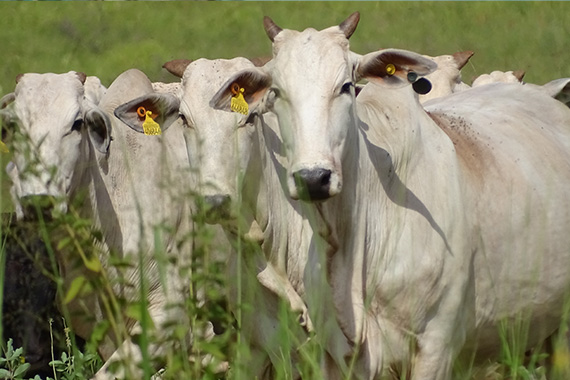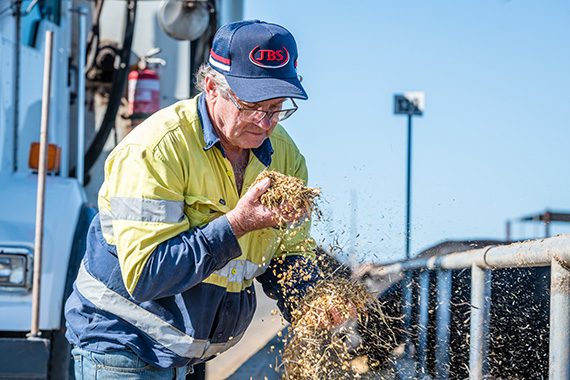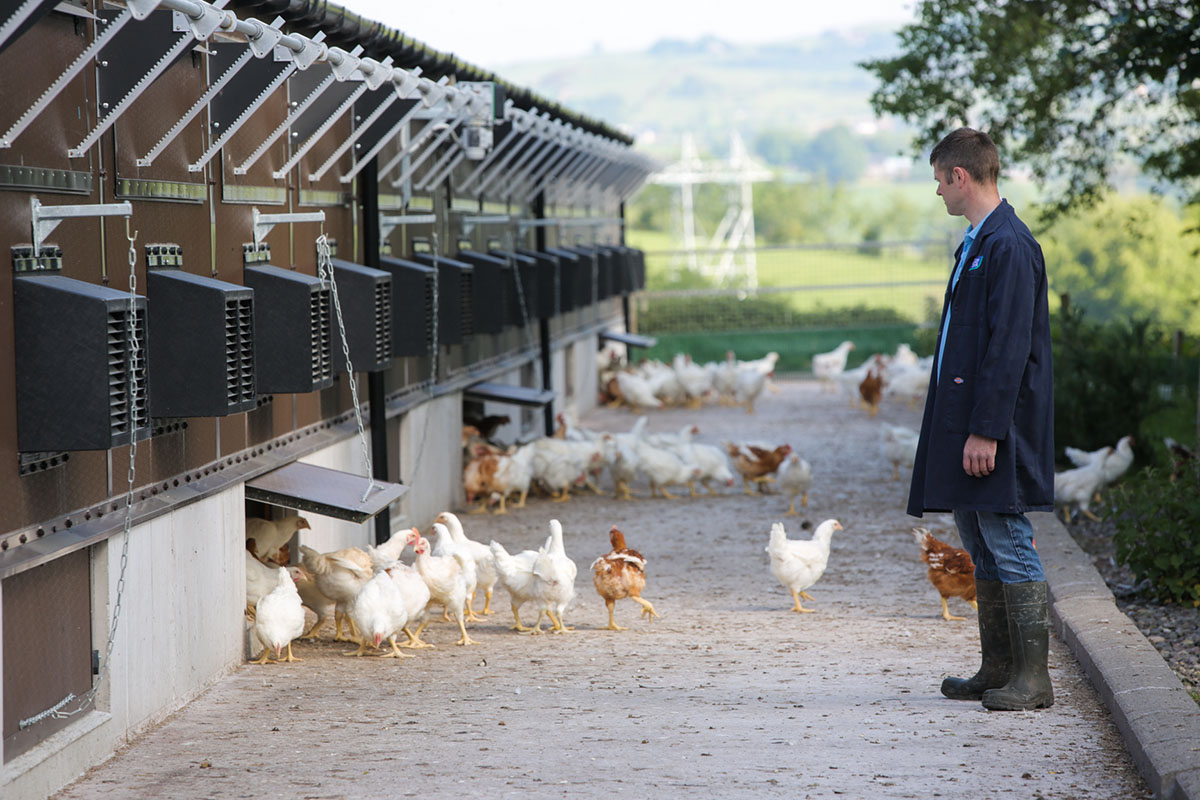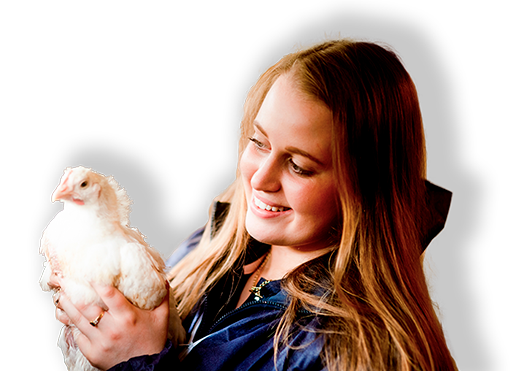Health and Nutrition
Assessing the daily needs and health status of the animals under our care is essential to ensuring their well-being. No matter the production system deployed, we are committed to providing our animals with proper nutrition and full-service veterinary care.


Monitoring Animal Health
Our Regional Approaches:
Australia:
Upon arrival at our Australian feedlots, cattle are immediately assessed for their overall health and nutrition status, provided individual identification tags, and vaccinated. They are then...
Australia:
Upon arrival at our Australian feedlots, cattle are assessed for their overall health and nutrition status, provided individual identification tags, and vaccinated. They are then checked daily for injury and illness by experienced pen riders. If an animal is identified as requiring additional care, it is moved to the hospital area, where it is provided treatment under the direction of our veterinarians and animal health technicians.
Our Rivalea farming operations have developed and implemented an animal health program under guidance from company veterinarians and based on the Australian Pork Industry Quality Assurance Program (APIQ) Standards Module 3: Animal Welfare Standards and Module 4: Biosecurity Standard. The plan incorporates regular veterinary farm consultations, focused management programs, and biosecurity protocols. The business relies on trained, competent team members, who recognize early signs of animal illness, so that appropriate preventative and/or remedial action can be administered under veterinary guidance.
At Huon, fish populations are observed daily to help ensure their health and welfare requirements are met. On-site cameras allow for direct assessment of health, condition, feed response, and behavior in all marine populations, and additional targeted health checks are undertaken regularly to ensure a full understanding of the health and welfare status of each population. A comprehensive list of animal welfare parameters are monitored and documented at every handling event. These metrics are reviewed through daily reports, weekly meetings, internal audits and end of period reviews of performance against targets.
Brazil:
At Seara, we guarantee that our supplier partners comply with our animal welfare guidelines by training our team members and monitoring chicken flocks and swine herds. Our technical teams...
Brazil:
At Seara, we guarantee that our supplier partners comply with our animal welfare guidelines by training our team members and monitoring chicken flocks and swine herds. Our technical teams and partners are trained in technical guidelines and internal procedures that define the best practices for animal nutrition and health. Seara also monitors the origin, quality, and nutritional value of the raw commodities that formulate the feed provided to our chickens and hogs, in addition to the volume of feed provided, the medications provided, and the stocking density. These assessments are carried out regularly, enabling preventive actions.
In Seara’s hog supply chain, 100% of farms do not practice teeth clipping in pigs. Additional actions are also currently being adopted, such as implementing environmental enrichment on farms and monitoring proper breeding densities to enable the expression of natural behaviors and avoid animal stress.
Europe:
Within Pilgrim’s Europe’s higher welfare hog supply chain, we make sure that our farm partners thoroughly understand our animal welfare requirements, and regularly support them through farm...
Europe:
Within Pilgrim’s Europe's higher welfare hog supply chain, we make sure that our farm partners thoroughly understand our animal welfare requirements, and regularly support them through farm visits and trainings on animal husbandry, welfare and health provided by our own team of experienced field staff and veterinarians. We also host quarterly update meetings with our family farm partners that include training initiatives.
In our Pilgrim's Europe Chicken business, chicken flock monitoring is conducted a minimum of once, but typically 2-3 times in every flock cycle by our field teams as part of their welfare audit program. This allows our team members to work along with our farmers to identify any sign of these issues early and agree with the farmer corrective actions such as alteration of ventilation or drinking systems if required
Mexico:
Pilgrim’s Mexico does not perform physical alterations to any of our chickens. In the Pilgrim’s supply chain, we only purchase roosters...
Mexico:
To help assure the proper management and monitoring of their birds’ health in long-cycle poultry and broiler farms, our Pilgrim’s Mexico team utilizes a variety of practices, including daily inspections, continuous vaccination and preventative medicine programs, and more. Flocks are inspected at least twice a day to confirm if conditions such as bird health and mobility, feed and water levels, and facility safety, lighting, temperature, humidity, ventilation, air quality, and stocking density meet Pilgrim’s Mexico standards.
United States:
Both our U.S. live pork operation staff and contract sow and finishing partners monitor the health of hogs daily. Production field managers and veterinarians provide support to each...
United States:
Both our U.S. live pork operation staff and contract sow and finishing partners monitor the health of hogs daily. Production field managers and veterinarians provide support to each contract partner, visiting the farm regularly and remaining on call 24 hours a day, seven days a week, to maintain the health of our hogs. Field managers inspect the health and nutrition status of the pigs to make sure that our nutrition and health programs are implemented appropriately and that animals are in optimal condition.
Pilgrim’s poultry farm partners are required to inspect their chicken houses and the chickens at least twice a day. During these reviews, they evaluate housing conditions such as ventilation, air quality, water, feed lines and bedding material quality, and closely observe eye health and lameness. Any chickens unable to thrive are humanely euthanized using an American Veterinary Medical Association or equivalent approved techniques, such as cervical dislocation. Pilgrim’s technicians also work with each farm family, visiting regularly and remaining on call for the farm 24 hours a day, seven days a week, to maintain the health of our flocks. Our technicians inspect both the farm and the chickens during their visit, monitoring health factors such as eye and leg health, mortality, house and farm conditions, rodent and/or pest issues, proper ventilation, ammonia levels, litter condition, adequacy of feed intake and water supply. Pilgrim’s technicians not only monitor the farm’s health plan; they also share best practices on how to raise healthier chickens.
Veterinary Care
Our licensed veterinarians establish and monitor health and vaccine protocols and follow government regulations. They perform routine health checks and are available for consultation on any issue.
Each facility has a dynamic written health plan that is developed in consultation with our veterinarians and includes specifications regarding animal management, vaccination schedules, animal-health monitoring and treatment, mortality and morbidity monitoring, and measures taken to prevent disease transmission. They also work to mitigate or eliminate pain for our animals.
Physical Alterations
Our Regional Approaches
Australia:
At our Australian feedlots, we work diligently to purchase cattle that have been pre-conditioned, meaning they have been previously castrated and disbudded (if necessary) at a young...
Australia:
At our Australian feedlots, we work diligently to purchase cattle that have been pre-conditioned, meaning they have been previously castrated and disbudded (if necessary) at a young age, vaccinated and weaned before arriving at our feedlots.
Rivalea does not permit teeth clipping, surgical castration, ear notching, or tusk trimming on any of its hogs and does not use nose rings on sows. Tail docking is avoided wherever possible. Where tail biting is a problem, all aspects of the environment, feeding, health, and management are investigated to identify the contributing factors so that remedial action can be taken. Where tail docking is required as a preventative measure, it is performed under veterinary direction within 7 days of birth. Cauterization of tail docking is used as this was demonstrated to be the optimal method during our collaborative research.
No commercial fish populations at Huon are subjected to any mutilation. Specific research and development trials may include clipping of the adipose fin as a method of identification, but in all cases must only be performed on anesthetized fish and include measures that aim to prevent infection at the wound site.
Brazil:
In our Seara poultry operations, no animal husbandry practices are used that cause pain or mutilation. For example, no debeaking is performed on our broiler chickens...
Brazil:
In our Seara poultry operations, no animal husbandry practices are used that cause pain or mutilation. For example, no debeaking is performed on our broiler chickens.
In our Seara pork operations, procedures that cause pain or discomfort are discouraged, and 100% of the male hogs are not subjected to surgical castration, as immunocastration technology is used.
Europe:
The Pilgrim's Europe Pork business does not permit routine tail docking or castration. Our current research includes a project examining pig behavior and its impact upon tail biting. The objective...
Europe:
The Pilgrim's Europe Pork business does not permit routine tail docking or castration. Our current research includes a project examining pig behavior and its impact upon tail biting. The objective is to understand more about causal factors associated with tail biting and how tail docking can be reduced.
The Pilgrim's Europe Chicken business does not perform surgical procedures on any of our chickens nor any physical alterations to our broilers. In the Pilgrim’s supply chain, we only purchase roosters and hens from breeding companies that have strict protocols in place to minimize stress related to these procedures. In the event that aggression or injurious pecking is observed in Moy Park breeders, veterinary and technical advice is sought on how to minimize impact. De-toeing and infrared beak treatment may be carried out on the day of hatch by trained personnel if physical treatment is deemed necessary to prevent extensive welfare issues during the productive cycle.
Mexico:
Pilgrim’s Mexico does not perform physical alterations to any of our chickens. In the Pilgrim’s supply chain, we only purchase roosters and breeders from breeding companies that...
Mexico:
Pilgrim’s Mexico does not perform physical alterations to any of our chickens. In the Pilgrim’s supply chain, we only purchase roosters and hens from breeding companies that have strict protocols in place to minimize stress related to these procedures.
United States:
In the U.S., we perform tail docking and castration procedures on our hogs according to the protocols and standards outlined in our animal welfare program...
United States:
In the U.S., we perform tail docking and castration procedures on our hogs according to the protocols and standards outlined in our animal welfare program.
Pilgrim’s U.S. does not perform physical alterations to any of our chickens. In the Pilgrim’s supply chain, we only purchase roosters and hens from breeding companies that have strict protocols in place to minimize stress related to these procedures.
Animal Nutrition
Providing the proper nutrition to maintain appropriate body condition and optimize growth is critical to the overall health and welfare of our animals. At our livestock and poultry operations, our team of Ph. D.’s and expert nutritionists formulate diets specific to the animal’s species and life stage and adjusts diets, daily if necessary, to optimize growth and prevent nutritional deficiencies and digestive disorders. We manufacture our own feed in company-owned and contracted feed mills, using a proprietary mixture that includes corn, ground hay (for cattle) and other grains. At our aquaculture operations, we purchase feed from accredited third-party suppliers.

Antibiotic Use
At JBS, the use of antibiotics in animals is subject to local regulations.
Our Regional Approaches:
Australia:
In our Australian beef and smallstock operations, all antibiotics are used under the supervision of qualified and registered veterinarians and only to prevent, control or to...
Australia:
In our Australian beef and smallstock operations, all antibiotics are used under the supervision of qualified and registered veterinarians and only to prevent, control, or to treat disease, rather than growth promotion or feed efficiency. Antibiotics are used by JBS therapeutically and, in special risk circumstances, prophylactically based on a prescription from a Registered Veterinarian.
Our Northern and Southern Australian feedlots have initiated mandatory pre-vaccination of cattle demonstrating a higher risk rating for bovine respiratory disease (BRD) to prevent disease, and minimize the use of antibiotics effectively, and have initiated mandatory pre-vaccination of cattle demonstrating a higher risk rating for bovine respiratory disease (BRD).
Rivalea follows veterinary advice to treat an animal or group of animals, and any antibiotics that are used are under prescription of registered veterinarians in strict accordance with regulatory guidelines. All antibiotics are registered for use in food-producing animals by the APVMA and are either used for prophylactic use (to prevent the disease from occurring) or therapeutic use (treating disease). Rivalea records and monitors the use of antibiotics, and our veterinarians utilize extensive diagnostic testing and analysis to ensure the effective use of antibiotics. Furthermore, a comprehensive Research and Innovation program is used to identify, evaluate, and develop antibiotic alternatives. Rivalea also employs disease prevention strategies to reduce antibiotic use and regularly review and assess alternative programs to antibiotic use.
The use of prophylactic antibiotics is not allowed in Huon’s operations or those of its suppliers. Antibiotics will only ever be prescribed under the direction of a veterinarian for animal health and welfare reasons following a full investigation, confirmation of diagnosis through laboratory testing of fish health samples, and after confirming antibiotic sensitivity of causative organisms. A comprehensive vaccination program is critical in reducing antibiotic use, and Huon continues to invest and work collaboratively to ensure ongoing vaccine development. Good husbandry practices and a focus on biosecurity are also both essential
Brazil:
At JBS Friboi, the prophylactic use of antibiotics is discouraged. Friboi’s cattle suppliers are instructed on the responsible use of antibiotics and on the importance of veterinarian supervision to...
Brazil:
At JBS Friboi, the prophylactic use of antibiotics is discouraged. Friboi’s cattle suppliers are instructed on the responsible use of antibiotics and on the importance of veterinarian supervision to ensure animal health and food safety.
In Seara, the use of medications, vaccines, and other substances is subject to veterinary prescription and provided by the technical assistance team. The use of any such product that has not been expressly authorized by Seara is strictly prohibited. In swine farming, antimicrobials are not used prophylactically or as growth promoters.
Europe:
In Europe, records of medications used on farms are inspected by the auditors of the Red Tractor Scheme and by the local authority Animal Health inspectors as legally required...
Europe:
In Europe, records of medications used on farms are inspected by the auditors of the Red Tractor Scheme and by the local authority Animal Health inspectors as legally required.
The Pilgrim’s Europe Chicken business has an Antimicrobial Stewardship Forum focused on the education of poultry producers in antimicrobial resistance and best practices to reduce antimicrobial usage and collects comprehensive data to give the poultry industry and regulators a clear picture of poultry-usage trends. Moy Park also established a Food Safety Forum and Antibiotics Stewardship Forum, to ensure that our chickens are healthy and our products are safe. These forums include external experts who assist us with the latest scientific developments.
The Pilgrim’s Europe Pork business has introduced an industry leading initiative in our own higher welfare farming supply chains to reduce the need for antibiotic use by improving pig management and health. We have voluntarily implemented stringent controls on the use of Critically Important Antibiotics (CIAs). Since implementing our antibiotic stewardship strategy in 2013, we have reduced use by more than 70%. Antibiotic usage within our own higher welfare supply chain has been consistently below the U.K. swine sector target for 2023. Pilgrim’s UK’s independent supply partners, as part of the U.K. swine industry, have achieved the Responsible Use of Medicines in Agriculture Alliance (RUMA) target for the responsible use of antibiotics since its start in 2017.
Mexico:
At Pilgrim’s Mexico, the use of antibiotics is supervised by veterinarians. For traceability and control purposes, farms keep a record of these products, dosage and application period, to meet...
Mexico:
At Pilgrim’s Mexico, the use of antibiotics is supervised by veterinarians. For traceability and control purposes, farms keep a record of these products, dosage and application period, to meet the withdrawal times established by the governing body, The General Directorate of Animal Health, which is part of SENASICA. All antibiotics used are registered by The General Directorate of Animal Health.
United States:
In our U.S. beef and pork operations and Canadian beef operation, we support the judicious use of antibiotics under a valid VCPR (Veterinary Client Patient Relationship) and in accordance...
United States:
In our U.S. beef and pork operations and Canadian beef operation, we support the judicious use of antibiotics under a valid VCPR (Veterinary Client Patient Relationship) and in accordance with the Beef Quality Assurance (BQA) Judicious Use of Antimicrobials Guidelines for cattle and the Pork Quality Assurance Plus (PQA+) Antibiotic Principles for hogs. We endorse the prevention of disease in cattle and hogs to effectively minimize the use of antibiotics, as described in the BQA and PQA+ programs. Comprehensive individual and herd health programs should be in place at supplier operations, including routine vaccination, balanced nutrition, and optimal animal husbandry. When illness occurs, documented disease detection and prevention programs should be employed under the guidance of licensed veterinarians.
Under a VCPR and in accordance with the guidelines and principles listed in BQA and PQA+, we support the use of medically important antibiotics in our cattle and hog supply under the supervision of licensed veterinarians for therapeutic use only, defined as prevention, control, and treatment of disease, rather than growth promotion or feed efficiency.
To ensure the responsible use of antibiotics and the welfare of the cattle and hogs we purchase, we require the following:
Compliance with the BQA Guidelines for Judicious Use of Antimicrobials for cattle and the PQA+ Antibiotic Principles for hogs, which includes a VCPR;
Antibiotics classified as critical to human medicine are only used at therapeutic levels as prescribed by licensed veterinarians;
Sub-therapeutic use of medically important antibiotics is not practiced; and
Full compliance with Food and Drug Administration (FDA) Guidance 209 and 213 Veterinary Feed Directive (VFD) rule. This guidance discontinues the use of medically important antibiotics for growth promotion and requires veterinary oversight of all medically important antibiotics. All antibiotics listed by the FDA as important for human medicine require a VFD issued by a licensed veterinarian before they can be used in cattle or pig feed.
The farm and ranch partners who supply our cattle and hogs guarantee compliance to these requirements by completing an affidavit at the point of sale and are randomly third-party audited, ensuring compliance with BQA and PQA+. Our process-verified programs (natural, organic, grass-fed, antibiotic free, etc.) may require additional compliance depending upon specific program requirements.
At Pilgrim’s U.S., all antibiotics are used under the supervision of licensed and accredited Doctor of Veterinary Medicine and only for the purposes of preventing, controlling or treating disease, rather than growth promotion or feed efficiency. Pilgrim’s is focused on producing healthy animals through good hygiene and husbandry practices. Any use of antibiotics is strictly governed by national regulations and requires authorization by the overseeing Doctor of Veterinary Medicine who care for the poultry. Any medication used is licensed by the FDA and undergoes intense scrutiny before being approved for use.
Pilgrims’ U.S. has also been antibiotic free in all company hatcheries since 2016 and is fully compliant with the FDA Guidance 209 and 213 VFD rule. Any antibiotic use is under the strict guidance of the company’s licensed, USDA accredited and board-certified veterinarians and is strictly for disease prevention, control or treatment. The Pilgrim’s antibiotic policy is reviewed annually.
One of the initiative’s primary focuses has been understanding liver abscesses in beef and dairy cattle. Current control methods for preventing liver abscesses from forming involve administering antibiotics to entire groups of animals, including those that are healthy as it is difficult to determine which animals are infected. In 2023, ICASA awarded four grants totaling roughly US$1.15 million to identify why liver abscesses occur and develop diagnostic tools to enable informed decision-making to treat the condition. The awarded initiatives evaluated modeling for genomic, blood, and microbiological markers for liver abscesses in fed beef cattle, understanding liver pathogenesis and risk factors of feedlot cattle reared in conventional beef versus dairy management systems, and metabolic analysis of blood plasma to identify unique biomarkers that indicate liver abscesses.
Alternatives to Antibiotics
We are committed to reducing the use of antibiotics in animal production and have conducted extensive research to optimize animal management to reduce the incidence of disease and identify other products that promote and strengthen animal health and disease prevention.
While innovation, adoption of new products, and improving management practices reduce the incidence of disease, antibiotics and ionophores are still required in some cases for the treatment and prevention of disease. Our veterinary and nutrition teams will continue to work closely with companies that produce these alternative compounds, as well as universities and private researchers to make sure that we are on the leading edge of innovation as we continue to provide our customers with wholesome, healthy, and nutritious meat and poultry products.
Cloning and Genetic Engineering
JBS operates under the appropriate guidelines regarding animal genetics. We do not raise or knowingly source animals that have been cloned or genetically modified, edited, or engineered. To our knowledge, tracking mechanisms for these animals are not currently in place in many of our countries of operation. We are also aware that scientific developments which may benefit the health and well-being of animals are ongoing and we will continue to review and scrutinize this research in partnership with our customers.

